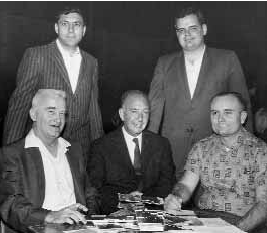
To be or Not to be Endplayed: That is the question. Photo: Bob Hamman, Eddie Kantar, Don Krauss, Peter Leventritt, Lew Mathe, Howard Schenken.
The Milwaukee Sentinel – Dec 10, 1970
|
 9 7 5 3 9 7 5 3
 4 3 4 3
 K 10 4 K 10 4
 A K J 3 A K J 3 |
|
 8 8
 A K Q J 9 A K Q J 9
 Q 9 8 6 Q 9 8 6
 9 6 2 9 6 2 |
|
 K 10 6 4 K 10 6 4
 10 8 6 10 8 6
 7 5 2 7 5 2
 Q 8 7 Q 8 7 |
|
 A Q J 2 A Q J 2
 7 5 2 7 5 2
 A J 3 A J 3
 10 5 4 10 5 4 |
| West |
North |
East |
South |
1 |
Pass |
Pass |
Dbl |
| Pass |
2 |
Pass |
2 |
| Pass |
4 |
All Pass |
|
Opening lead:

K
To be or Not to be Endplayed: That is the question.
At least that is the frequently the question when really competent players are in opposition. Avoiding your opponents’ endplays surely is as important as producing your own endplays, yet the subject has been largely neglected by bridge writers.
To defeat an endplay, you have to be able to see what’s coming and act accordingly. For example, if declarer is planning to force your partner to lead into his A Q, you must cook his goose by leading through the A Q while there is still time.
Preventing an endplay isn’t easy, as shown in this deal in the world championship. On the surface, it seemed South was bound to lose four tricks, but he circumvented one of them by means of an endplay, which West could have forestalled.
West began with two rounds of hearts and shifted to a club. Declarer read East for the queen of the suit and therefore took the ace. Then he finessed the queen of trumps, ruffed a heart and finessed again in trumps.
After cashing the ace of trumps, he played three rounds of diamonds, finessing against West and finishing in his own hand. Then he exited with his last trump, forcing East to return a club up to the dummy’s K J and so landing a well played hand.
Against such a skilled declarer as this, a defender has to be right on his toes. West should shift to a club after only one round of hearts. Sooner or later he is bound to come in again with a heart and then he plays a second club, destroying the endplay…

 To be or Not to be Endplayed: That is the question. Photo: Bob Hamman, Eddie Kantar, Don Krauss, Peter Leventritt, Lew Mathe, Howard Schenken.
The Milwaukee Sentinel – Dec 10, 1970
To be or Not to be Endplayed: That is the question. Photo: Bob Hamman, Eddie Kantar, Don Krauss, Peter Leventritt, Lew Mathe, Howard Schenken.
The Milwaukee Sentinel – Dec 10, 1970




























